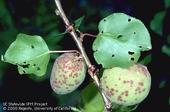- Author: Belinda Messenger-Sikes

After years of drought, we welcome rain in California. But we also recognize that rain can help spread a number of plant diseases. Rain and wind can splash bacteria and fungi from infected leaves, branches, and blossoms to uninfected parts of the tree. The fungal diseases anthracnose, peach leaf curl, scab, shot hole blight, and the bacterial disease fire blight can all be spread by rain splash. This ability to spread by water makes these diseases more common after a wet spring. With 2023 bringing quite a bit of rainfall and 2024 looking similarly wet, we want to focus on some common rain-dispersed diseases.
Anthracnose
Anthracnose affects many trees including almond, citrus, Chinese elm, and...
- Author: Igor Lacan
![Figure 1. [J.K. Clark]](https://ucanr.edu/blogs/UCIPMurbanpests/blogfiles/38768small.jpg)
[From the August 2016 issue of the UC IPM Green Bulletin]
Two “sap flux” diseases observed in landscape trees—bacterial wetwood (or slime flux) and alcoholic (“foamy”) flux—often trigger demands that a landscaper “do something.” Yet the most appropriate action may be to provide cultural care and to monitor for any additional problems rather than to apply chemicals or undergo drastic “tree surgery.”
Symptoms
A single wound or bark crack located on the trunk or a large branch...
![Cluster of ripe apricots [J.K.Clark]](https://ucanr.edu/blogs/UCIPMurbanpests/blogfiles/31578small.jpg)
Although most fruit trees are pruned during the dormant season, in areas with wet winters, apricots and cherries should be pruned in late summer to allow time for the pruning wounds to close. Pruning apricots and cherries during the rainy season could lead to detrimental canker diseases.
Cherries, apricots, and a few related species are particularly susceptible to fungal and bacterial canker diseases, including Eutypa dieback, Botryosphaeria canker, and bacterial canker. Pathogens can be spread by rain or tree wounds – such as pruning wounds – during wet weather; subsequent infections spread through the wood for several years and may eventually kill the tree.
Late summer is the best time to do final...


